Page 5 of 276
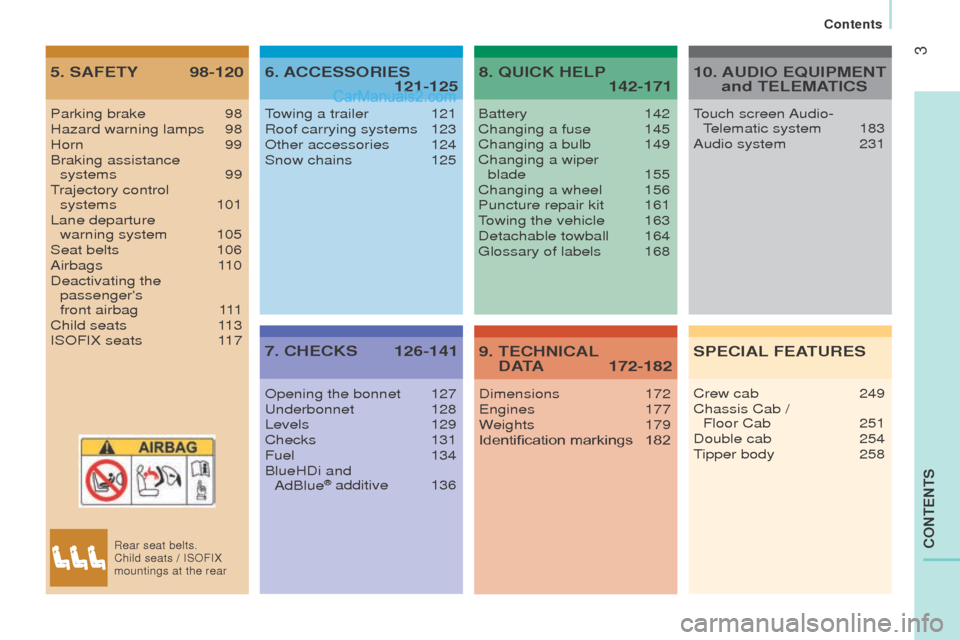
3
cont
Ent
S
5. SAFEtY 98-120 6. AccESSorIES 121-125
7.
cHEcKS 126-141 8.
QuIcK HELP
142-171
9.
tEcHnIcAL
dAtA 172-182
Parking brake 98
Hazard warning lamps 98
Horn 99
Braking assistance systems
99trajectory control systems 101
Lane departure warning system
105
Seat belts 106
Airbags 1
10
Deactivating the passenger's
front airbag
11
1
Child seats
113
ISOFIX seats 117
towing a trailer 121
Roof carrying systems 123
Other accessories 124
Snow chains 125
Opening the bonnet
127underbonnet 128
Levels 129
Checks 131
Fuel 134
BlueHDi and AdBlue
® additive 136 Battery
142
Changing a fuse 145
Changing a bulb 149
Changing a wiper blade
155
Changing a wheel 156
Puncture repair kit 161towing the vehicle 163
Detachable towball 164glossary of labels 168
Dimensions
172engines 177
W
eights
179
Identification markings 182
10. AudIo EQuIPMEnt
and tELEMAtIcS
SPE
cIAL
FEA
turES
touch screen Audio-telematic system 183
Audio system 231
Crew cab
249
Chassis Cab / Floor Cab
251
Double cab 254tipper body 258
Rear seat belts.
Child seats / ISOFIX
mountings at the rear
Contents
Page 15 of 276
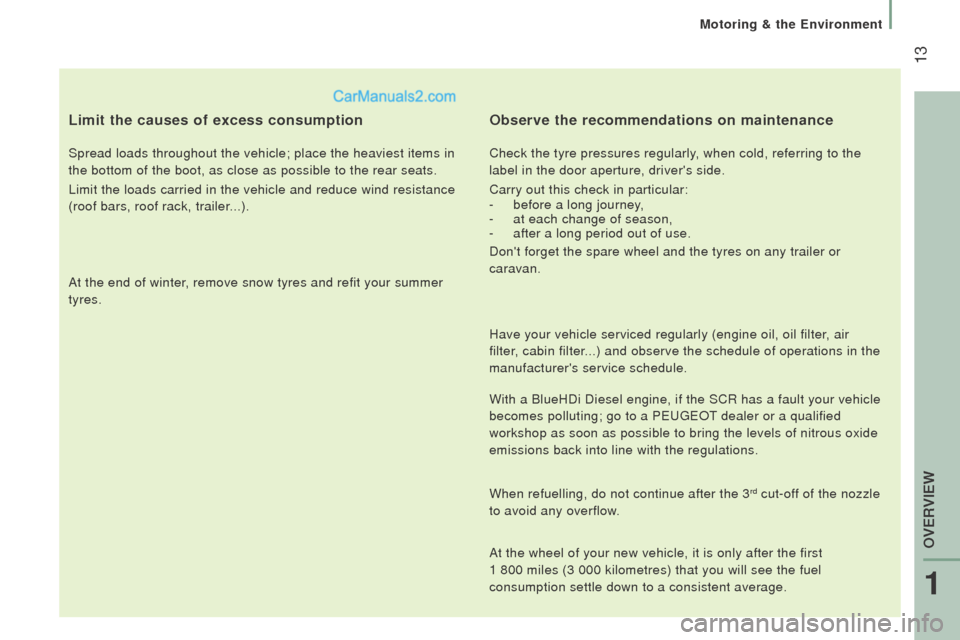
13
Limit the causes of excess consumption
Spread loads throughout the vehicle; place the heaviest items in
the bottom of the boot, as close as possible to the rear seats.
Limit the loads carried in the vehicle and reduce wind resistance
(roof bars, roof rack, trailer...).
At the end of winter, remove snow tyres and refit your summer
tyres.
observe the recommendations on maintenance
Check the tyre pressures regularly, when cold, referring to the
label in the door aperture, driver's side.
Carry out this check in particular:
-
before a long journey,
- at each change of season,
- after a long period out of use.
Don't forget the spare wheel and the tyres on any trailer or
caravan.
Have your vehicle serviced regularly (engine oil, oil filter
, air
filter, cabin filter...) and observe the schedule of operations in the
manufacturer's service schedule.
With a BlueHDi Diesel engine, if the SCR has a fault your vehicle
becomes polluting; go to a P
eugeOt dealer or a qualified
workshop as soon as possible to bring the levels of nitrous oxide
emissions back into line with the regulations.
When refuelling, do not continue after the 3
rd cut-off of the nozzle
to avoid any overflow.
At the wheel of your new vehicle, it is only after the first
1
800 miles (3 000 kilometres) that you will see the fuel
consumption settle down to a consistent average.
1
OVeRVIeW
Motoring & the environment
Page 123 of 276
121
toWInG A trAILEr...
the type-approved towable weights are
entered in your vehicle's registration
certificate, as well as on the manufacturer's
VIN plate.these weights are also given in sales
brochures. You will then have information on your
vehicle's ability to tow a trailer, a caravan,
a boat...
Refer to the "
technical data - Vehicle
identification" section. For the maximum unbraked trailer
weight and the recommended nose
weight, refer to the "
technical data -
W
eights" section.
6
transport solutions
ACCeSSORIeS
Page 124 of 276
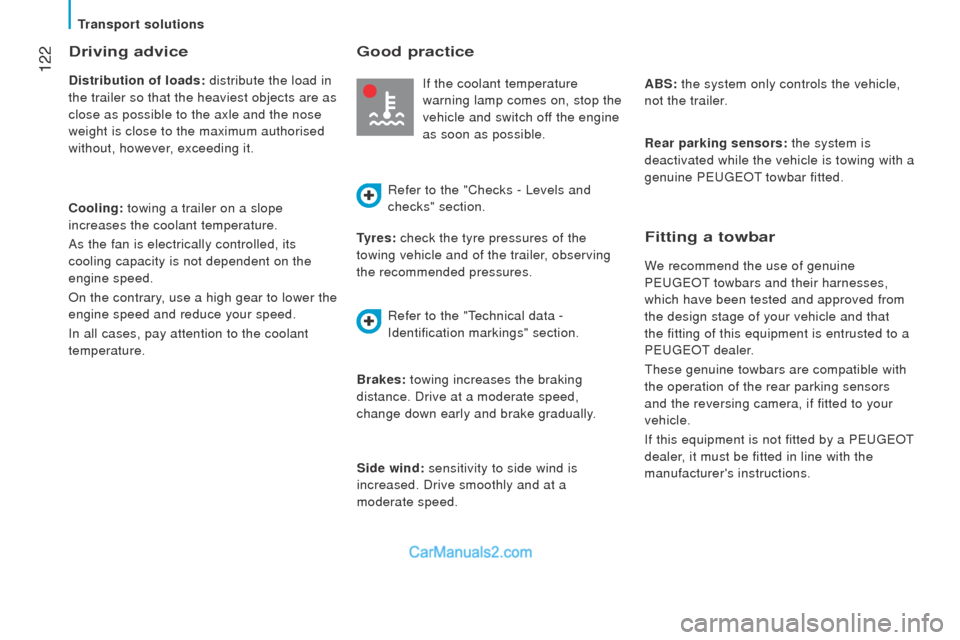
122
driving advice
distribution of loads: distribute the load in
the trailer so that the heaviest objects are as
close as possible to the axle and the nose
weight is close to the maximum authorised
without, however, exceeding it.
cooling:
towing a trailer on a slope
increases the coolant temperature.
As the fan is electrically controlled, its
cooling capacity is not dependent on the
engine speed.
On the contrary, use a high gear to lower the
engine speed and reduce your speed.
In all cases, pay attention to the coolant
temperature.
tyres: check the tyre pressures of the
towing vehicle and of the trailer, observing
the recommended pressures.
Fitting a towbar
We recommend the use of genuine
P
eugeOt towbars and their harnesses,
which have been tested and approved from
the design stage of your vehicle and that
the fitting of this equipment is entrusted to a
P
eugeOt dealer.
these genuine towbars are compatible with
the operation of the rear parking sensors
and the reversing camera, if fitted to your
vehicle.
If this equipment is not fitted by a P
eugeOt
dealer, it must be fitted in line with the
manufacturer's instructions.
Good practice
If the coolant temperature
warning lamp comes on, stop the
vehicle and switch off the engine
as soon as possible.
Refer to the "Checks - Levels and
checks" section.
Brakes: towing increases the braking
distance. Drive at a moderate speed,
change down early and brake gradually. Side wind: sensitivity to side wind is
increased. Drive smoothly and at a
moderate speed. ABS: the system only controls the vehicle,
not the trailer.
rear parking sensors:
the system is
deactivated while the vehicle is towing with a
genuine P
eugeOt towbar fitted.
Refer to the "
technical data -
Identification markings" section.
transport solutions
Page 166 of 276
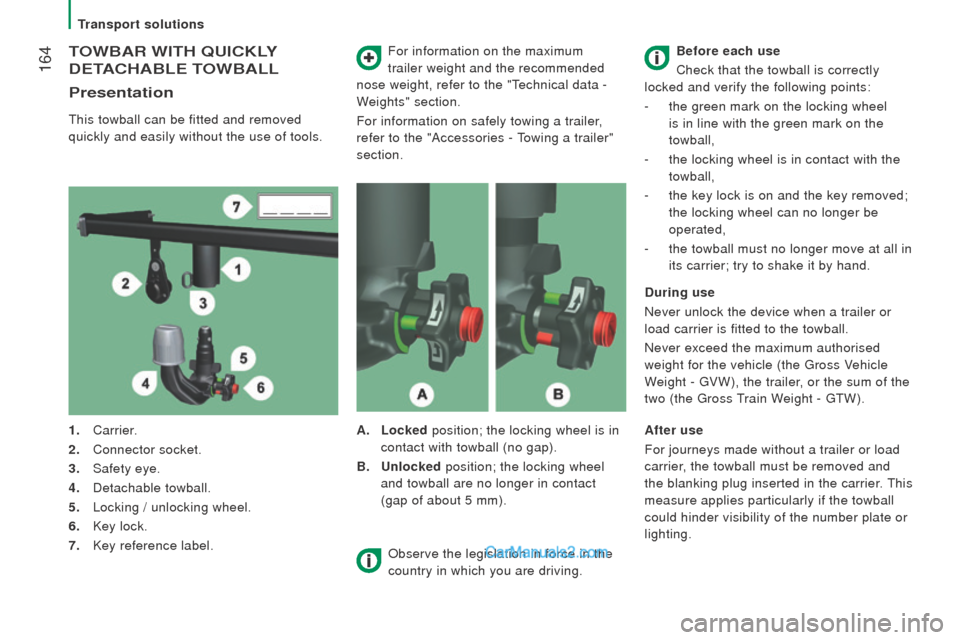
164
toWBAr WItH QuIcKLY
d
EtAcHABLE t
o
WBALL
Presentation
this towball can be fitted and removed
quickly and easily without the use of tools. For information on the maximum
trailer weight and the recommended
nose weight, refer to the "
technical data -
W
eights" section.
For information on safely towing a trailer,
refer to the "Accessories -
towing a trailer"
section.
1.
Carrier
.
2.
Connector socket.
3.
Safety eye.
4.
Detachable towball.
5.
Locking / unlocking wheel.
6.
Key lock.
7.
Key reference label. A.
Locked position; the locking wheel is in
contact with towball (no gap).
B.
unlocked
position; the locking wheel
and towball are no longer in contact
(gap of about 5 mm). Before each use
Check that the towball is correctly
locked and verify the following points:
- the green mark on the locking wheel
is in line with the green mark on the
towball,
-
the locking wheel is in contact with the
towball,
-
the key lock is on and the key removed;
the locking wheel can no longer be
operated,
-
the towball must no longer move at all in
its carrier; try to shake it by hand.
during use
Never unlock the device when a trailer or
load carrier is fitted to the towball.
Never exceed the maximum authorised
weight for the vehicle (the
gross V
ehicle
Weight -
gVW), the trailer
, or the sum of the
two (the
gross train Weight - gtW).
Observe the legislation in force in the
country in which you are driving. After use
For journeys made without a trailer or load
carrier, the towball must be removed and
the blanking plug inserted in the carrier.
this
measure applies particularly if the towball
could hinder visibility of the number plate or
lighting.
transport solutions
Page 168 of 276
166
removing the towball
Disconnect the trailer harness from the
socket 2 on the carrier.
Detach the cable on the trailer from the
safety ring 3 on the carrier.
unhook the trailer from the towball.
Refit the protective cover to the towball.
Remove the protective cover from the
towball.
Attach the trailer to the towball.
Attach the cable on the trailer to the safety
ring 3 on the carrier.
Connect the trailer harness to the socket 2
on the carrier. Remove the cap from the lock and press it
onto the head of the key.
Insert the key into the lock 6
.
Open the lock using the key.
transport solutions
Page 181 of 276
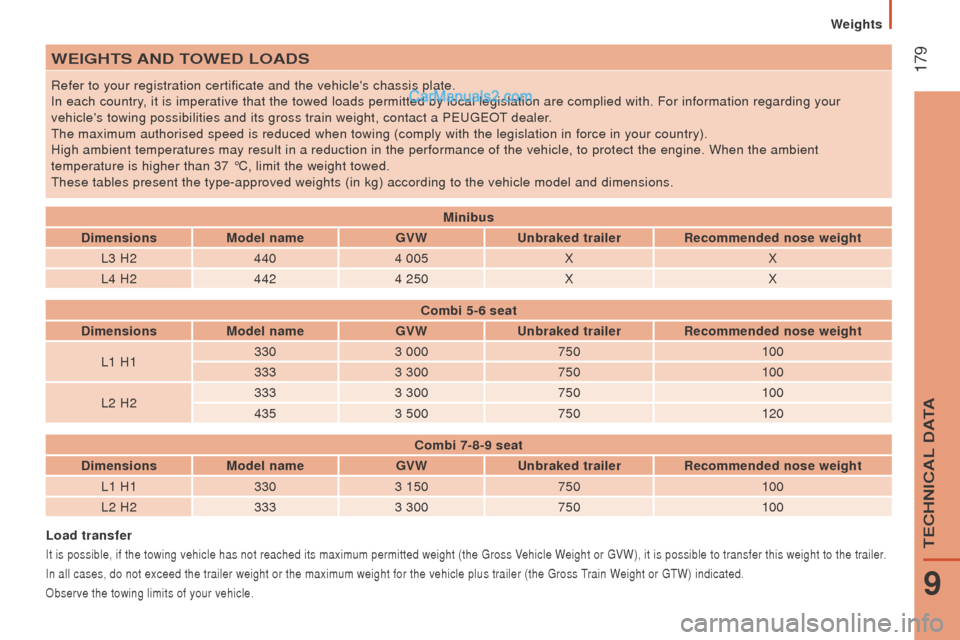
179WEIGHtS And toWEd LoAdS
Refer to your registration certificate and the vehicle's chassis plate.
In each country, it is imperative that the towed loads permitted by local legislation a\
re complied with. For information regarding your
vehicle's towing possibilities and its gross train weight, contact a P
eugeOt dealer.the maximum authorised speed is reduced when towing (comply with the leg\
islation in force in your country).
High ambient temperatures may result in a reduction in the performance o\
f the vehicle, to protect the engine. When the ambient
temperature is higher than 37 °C, limit the weight towed.
these tables present the type-approved weights (in kg) according to the\
vehicle model and dimensions.
Load transfer
It is possible, if the towing vehicle has not reached its maximum permit\
ted weight (the gross Vehicle Weight or gVW), it is possible to transfer this weight to the trailer.
In all cases, do not exceed the trailer weight or the maximum weight for\
the vehicle plus trailer (the
gross train Weight or gtW) indicated.
Observe the towing limits of your vehicle.
Minibus
dimensions Model name GVWunbraked trailerrecommended nose weight
L3 H2 4404 005 X X
L4 H2 4424 250 X X
combi 5-6 seat
dimensionsModel name GVWunbraked trailerrecommended nose weight
L1 H1 330
3 000 750 100
333 3 300 750 100
L2 H2 333
3 300 750 100
435 3 500 750 120
combi 7-8-9 seat
dimensionsModel name GVWunbraked trailerrecommended nose weight
L1 H1 3303 150 750 100
L2 H2 3333 300 750 100
9
teCHNICAL DAtA
Weights
Page 182 of 276
180Va n
dimensionsModel name GVWunbraked trailerrecommended nose weight
L1 H1 328
2 800 750 100
330 3 000 750 100
333 3 300 750 100
335 3 500 750 100
435 3 500 750 120
440 4 005 750 120
L1 H2 330
3 000 750 100
333 3 300 750 100
335 3 500 750 100
L2 H1 330
3 000 750 100
333 3 300 750 100
335 3 500 750 100
435 3 500 750 120
L2 H2 330
3 000 750 100
333 3 300 750 100
335 3 500 750 100
435 3 500 750 120
440 4 005 750 120
Weights